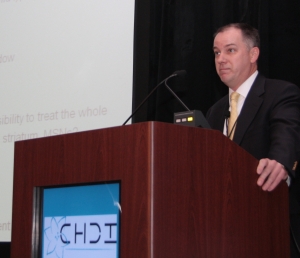
CHDI Report: Day 1
Day 1 of CHDI’s HD therapeutics conference: exploring abnormal brain connections and silencing the HD gene

In the first of our daily reports from CHDI’s annual HD therapies meeting in Palm Springs, we report on strategies to turn off the harmful gene and get brain cells communicating more effectively.
At the heart of the CHDI therapies meeting is three days of scientific presentations by world-leading scientists working to find effective treatments. These presentations covered a broad selection of different approaches to understanding and treating HD. The topics for the first day, Tuesday 8th February, were ‘Lowering Huntingtin Levels as a Therapeutic Approach’ and ‘Early Neuronal Dysfunction’.
Progress in Huntingtin Silencing

Image credit: Gene Veritas
The abnormal expanded HD gene is the root cause of all the problems of the disease. The gene tells all the body’s cells to produce an abnormal form of a protein called huntingtin. Proteins are the machines that enable cells to function, but the abnormal huntingtin protein, referred to as ‘mutant huntingtin’, is damaging to cells and causes them to malfunction and eventually die. If we could get rid of the harmful protein, there’s a good chance we could slow down the disease or even prevent the damage.
We can’t repair the gene problem directly in people’s brains, but scientists can design special targeted chemicals that enter cells and tell them ignore the message that would normally cause them to make the HD protein. The abnormal gene is still there, but the targeted molecules ‘silence’ its message so that cells produce less of the harmful protein. This ‘gene silencing’ technique one of the most promising ways to attack HD. Indeed, CHDI’s Chief Scientific Officer, Robert Pacifici, revealed in his opening address that CHDI aspires to spend 50% of their resources on huntingtin silencing, making it their top priority.
Several groups of researchers are working in parallel on different techniques to reduce the levels of a specific protein, including ‘RNA Interference (RNAi)’ and ‘antisense oligonucleotides (ASOs)’. These are slightly different types of targeted chemical, and we don’t yet know which will be best at silencing the gene.
Before we consider turning off the mutant huntingtin protein, we have to understand if there are any problems associated with this approach. Scott Zeitlin from the University of Virginia considered how much huntingtin is required to keep cells healthy. Everyone has two copies of the huntingtin gene – one from their mother and one from their father. Zeitlin’s group was one of three in the mid-1990’s to make mice with no huntingtin gene at all. These mice died before they were born, showing that huntingtin is very important during the development of an organism. But what about after the mouse is born – is huntingtin still important? Preliminary data suggest it is, and Zeitlin’s group has developed new mice that let him carefully control the amount of huntingtin they produce. The first of these mice just been born, and in the next months be should be able to use them to discover exactly how much huntingtin is needed to keep mice healthy.
Karen Chen works on a different disease altogether – spinal muscular atrophy (SMA), so why was she talking at an HD therapies conference? Well, like HD, SMA is caused by a single genetic mutation and it’s also a neurodegenerative disease – meaning that neurons malfunction and die prematurely. SMA researchers are also excited about techniques that can turn individual genes on or off.
The SMA Foundation has had encouraging results from animal trials to alter protein levels in SMA. They’ve been in discussion with the government agencies that regulate drug licensing, too, and they’re optimistic that a human trial of altering protein levels in SMA may be running by the end of 2011. Having trials like this already underway will make it easier for trials in HD to begin once the techniques and treatments have been perfected.
“Switching off the gene in animals has produced not only lower levels of huntingtin but also improvements in cells and symptoms”
There’s a myth that drug companies aren’t interested in working on treatments for HD because it’s too rare or too hard to treat. The presence of Andreas Weiss at this conference disproved that, because he heads up an HD research team at Novartis, one of the world’s biggest pharmaceutical companies. Novartis has been working on HD for several years now, and they’ve made impressive progress. They’re working on developing treatments that lower huntingtin levels, but they understand that being able to measure levels of huntingtin would be incredibly helpful, in order to choose the best drugs and test whether they’re working. Weiss’s team has developed an accurate way of measuring huntingtin based on the way they reflect light. These techniques will be really useful to the whole HD research community and it’s great to know that the resources of companies like Novartis are focused on the search for HD treatments.
This conference includes several scientific presentations from senior CHDI staff members, giving updates on their coordinated efforts. Doug Macdonald is CHDI’s Director of Drug Discovery and has been leading its huntingtin silencing work in collaboration with many different labs worldwide. CHDI is supporting several different huntingtin lowering techniques in parallel, to see as quickly as possible which technique is best and safest. Several teams have had success in switching off the gene in animals, producing not only lower levels of huntingtin but also improvements in cells and symptoms. Advances in drug design, and technologies that allow drugs to be pumped directly into the brain, are well on the way to overcoming problems with getting drugs to the parts of the brain where they’re needed. Finally, Macdonald hinted at success towards developing new brain scanning techniques that might eventually be able to tell us how much abnormal huntingtin is present in the brains of HD patients. Scans like that have been useful in other diseases like Alzheimer’s. Clearly CHDI’s huntingtin silencing efforts are making excellent progress.
Neuronal Communication in HD
Neurons are brain cells that speak to each other with chemical messages. These cells are the ones which enable our brains to work, and they’re the cells that are lost in HD. Neurons don’t interact randomly, they speak to each other at very specific sites called ‘synapses’. A synapse is a little connection between two neurons – in general, they can only speak to other cells via these hard-wired connections.
The process of communication between neurons is known to be changed in HD. Lynn Raymond from the University of British Columbia discussed her work trying to understand how brain cells are over-excited in HD. Too much chemical talk between neurons might be causing them to die early. Work in Raymond’s lab, and others, has shown that in HD model mice there is too much talk through a specific group of the channels that transmit messages at the synapses between neurons. Excitingly, drugs exist that might selectively correct the problems she described. One drug, Memantine, is approved for use in Alzheimer’s disease and when given to HD mice at a low dose corrected the over excitation she has seen in the mice. Her lab is continuing to work to understand the details of the process, in hopes of identifying additional ways of interfering with the process.
So there are differences in how neurons signal to each other, but why? Don Faber from Albert Einstein College of Medicine presented work from his group trying to understand how neuronal communication is changed in HD. Using a drug called retigabine, which is currently being tested in humans with epilepsy, he’s found that he can correct important parts of neuronal communication in neurons from HD mice. Along with CHDI, he’s planning experiments to see if this drug improves the mice’s symptoms.

Image credit: Gene Veritas
Because HD causes movement problems, a number of people are interested in studying the parts of the brain that control movement. Michael Orth, from the University of Ulm, is interested in a part of the brain called the ‘motor cortex’. The cortex is the wrinkly outer surface of the brain. Orth uses a technique called ‘transcranial magnetic stimulation’ to study this specific region. This technique uses very powerful magnets to make specific neurons ‘fire’ or signal to their neighbors. By placing the magnet on top of the region of the brain that controls the muscles in the hand, for example, he can make subjects flex certain muscles in their hand. Orth isn’t interested in playing puppets with HD patients, but rather how active the motor cortex region of their brain is. He has found that the motor cortex in people with the HD mutation require more stimulation to cause movements of the hand. This suggests that the motor cortex is ‘tuned down’ in people carrying the HD mutation, possibly even before they have HD symptoms. This technique could help scientists unravel how communication breaks down in the HD brain.
It’s clear that CHDI has made a firm decision to study communication through synapses as a major effort. Robert Pacifici suggested that 25% of CHDI’s efforts are being directed towards understanding and repairing changes at synapses in HD. Vahri Beaumont heads CHDI’s new team studying synapses, and gave a talk covering their efforts. This team will work to understand, first, how neuronal communication is altered in HD and second, how to fix these problems. They’re working to understand which of the many HD models in mice and rats best resemble HD patients in terms of changes to synapses. CHDI has 5 different drug development efforts that target different aspects of how synapses function in HD. One of these, in partnership with Pfizer Neuroscience, targets a protein called phosphodiesterase-10. Blocking the action of this protein in mice corrected most of the changes in synapses caused by the HD mutation. These drugs have become exciting new potential leads in HD.
NeuroSearch is a European company that has developed a drug known as ACR-16 or Huntexil for HD. Major clinical trials in Europe (MermaiHD) and North America (HART) have been conducted to examine the benefits of this drug in helping with some of the movement symptoms in HD. While not yet conclusive, the data from these studies suggest that the drug may be effective. Nicholas Waters, CEO of NeuroSearch, presented his companies work trying to use mice to understand in great detail how the drug works using mice. Understanding what scientists call the ‘mechanism of action’ could help NeuroSearch develop new and better drugs.
Sunset conclusions
Today was an exciting day of talks, covering a broad array of targets. It’s clear that CHDI has decided to focus its resources very clearly on specific areas. This gives us hope that these areas are closer to the development of drugs which might modify the course of HD. Stay tuned for more exciting research tomorrow!
Learn more
Sources & References
For more information about our disclosure policy see our FAQ…


